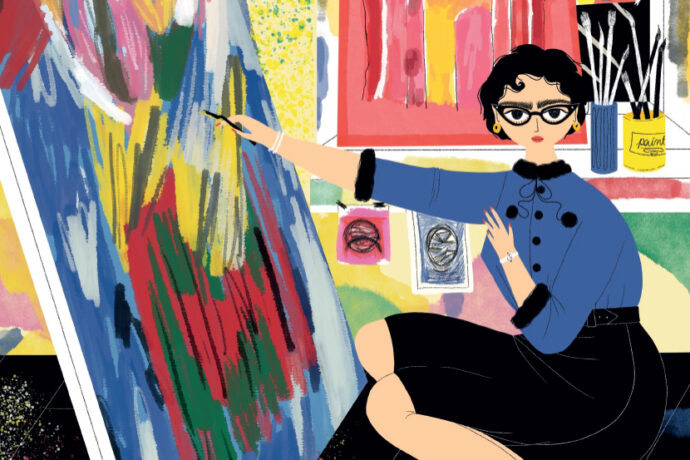
Your brain is wired to focus on the negative. Here’s how to shift towards joy and grow the good.
The way we experience life is largely shaped by what we choose to remember. So, how can we ensure that the positive moments don’t quietly slip away?
When my teenagers leave their wet towels on the bathroom floor, or my dearest friend forgets my birthday, I remind myself of the “magic ratio” of 5:1. This rule suggests that for every negative act, those we hold dear must perform five positive ones to create balance.
We all have a tendency to dwell on the negative, a human instinct known as “negativity bias.” It’s a reminder of how this bias colours the ordinary moments of life, making us focus more on what goes wrong than what goes right. Our brains are hardwired to quickly store negative experiences, making them feel more immediate and emotionally charged. In contrast, positive experiences often fail to stick unless we consciously focus on them. Without our active attention, they fade into the background of short-term memory.
While this bias was once essential for survival – helping us detect threats like a sabre-toothed tiger – if left unchecked, it can skew our perception of the world, our relationships, and even ourselves.
How does negativity affect you?
Do you:
- Lie awake at night, replaying that one offhand comment you made in a meeting, rather than recognising the many valuable contributions you made?
- Focus on one moment of indulgence or a day when you didn’t feel as active, while overlooking all the times you’ve supported your wellbeing and made choices that feel good for you?
- Dwell on the one time you raised your voice with your children, neglecting the countless moments you were patient and composed?
How can we make positive experiences stick?
The most effective way to counter negativity bias is by practising what neuroscientists term “growing the good.”
Here’s how:
- Notice the good. When your child offers you a warm hug, your partner makes you a cup of tea, or you witness the first flowers of spring, pause and truly savour the moment.
- Grow the good. To deepen the moment, engage your senses. Take a slow, deliberate breath and notice how your body responds – whether it’s a sense of calm or a burst of aliveness. As you linger in the moment, trust that you are embedding this experience into long-term memory, allowing it to become a lasting source of joy.
Why positivity can be hard to maintain
So, why isn’t it easier to dwell in these small moments of safety, connection, and joy? Despite our best individual intentions, we exist in a world that often amplifies fear, insecurity, and comparison. The media, political discourse, and societal pressures frequently focus on what’s wrong rather than what’s right. In such an environment, it can feel like swimming against the current to embrace the good.
But the real obstacle isn’t external factors like politics or culture – it’s our ego. The ego thrives on separation, self-doubt, and fear, keeping us disconnected from our true selves and others.
To recognise how your ego manifests, consider the repetitive, often negative thoughts it feeds you. These are the stories it uses to maintain control. Maybe your ego convinces you that something bad will happen if you stop worrying or allow yourself to enjoy life. Perhaps it whispers that you don’t deserve love or success, or that revealing your authentic self will lead to rejection. Or it may emerge when others succeed, trying to convince you that there isn’t enough love, success, or happiness to go around.
Ways to quiet the inner critic
- Get to know your ego. Cultivate curiosity about the negative thoughts it generates. Notice when they arise and what triggers them. The repetitive stories you tell yourself are usually the voice of your ego.
- Normalise the resistance. Understand that your ego will resist as you focus on the good. Recognise this resistance as a natural part of the process, a sign that you’re moving in the right direction.
- Be firm. When your ego tries to sabotage a positive moment, calmly but firmly assert, “Not now.”
- Practise mindfulness and gratitude. When you experience something inherently good, pause to take a mindful breath and acknowledge the moment with gratitude.
Understanding ego
Through my work with people around the world, guiding them to balance out their negativity bias through
mindfulness, meditation, and self-enquiry, I’ve noticed a recurring theme: our egos tell us the same story – that we are not enough and must remain guarded. Whether your ego tells you that you’re “too much” or “not enough,” the core message is the same: it’s not safe to be fully ourselves.
Over the years, I’ve learned to view this insight as a powerful tool. I imagine a collective, universal ego – a shared energy we all tap into. By conceptualising it this way, I create space between myself and its influence, helping me unhook from its voice.
This shared ego also brings a sense of connection to others. I picture us all walking through life, each of us tethered to this collective force. This perspective diminishes the tendency to compare and fosters compassion for the human experience.
Connection as a path to joy
In a world that often feels divided, one of the most profound shifts we can make is to realise that we are all connected by the same human experience. This recognition can dissolve the ego’s need for comparison, self-doubt, and insecurity.
By embracing this sense of collective belonging, we can move from feelings of isolation to a deep understanding of the shared human condition. We are not in this alone. Our struggles and successes, our joys and hardships, bind us together in a meaningful way.
Each day presents countless opportunities for connection, safety, and belonging. A hearty laugh with an old friend. The simple pleasure of biting into a perfectly ripe piece of fruit. The joyous greeting of your dog after a long day. These seemingly small moments hold immense power. Linger in them. Because, as we all know, the little things are far from little – they are, in fact, the essence of life.
❤︎ Ready to explore how you can grow the good and cultivate more joy in your life? Download this Sowing Seeds of Joy activity to pause for a moment of positive reflection. ❤︎
WORDS: Fleur Chambers



















